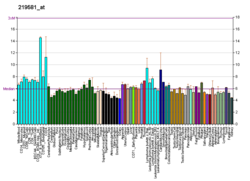| TSEN2 |
|---|
|
| Identifiers |
|---|
| Aliases | TSEN2, PCH2B, SEN2, SEN2L, tRNA splicing endonuclease subunit 2 |
|---|
| External IDs | OMIM: 608753; MGI: 2141599; HomoloGene: 41622; GeneCards: TSEN2; OMA:TSEN2 - orthologs |
|---|
| Gene location (Human) |
|---|
 | | Chr. | Chromosome 3 (human)[1] |
|---|
| | Band | 3p25.2 | Start | 12,484,421 bp[1] |
|---|
| End | 12,541,549 bp[1] |
|---|
|
| Gene location (Mouse) |
|---|
 | | Chr. | Chromosome 6 (mouse)[2] |
|---|
| | Band | 6|6 E3 | Start | 115,521,625 bp[2] |
|---|
| End | 115,555,589 bp[2] |
|---|
|
| RNA expression pattern |
|---|
| Bgee | | Human | Mouse (ortholog) |
|---|
| Top expressed in | - buccal mucosa cell
- mucosa of transverse colon
- gonad
- ventricular zone
- testicle
- gastrocnemius muscle
- body of pancreas
- cerebellar hemisphere
- right uterine tube
- muscle of thigh
|
| | Top expressed in | - Rostral migratory stream
- yolk sac
- epiblast
- primitive streak
- interventricular septum
- hand
- superior cervical ganglion
- otolith organ
- embryo
- utricle
|
| | More reference expression data |
|
|---|
| BioGPS |  | | More reference expression data |
|
|---|
|
| Gene ontology |
|---|
| Molecular function | - tRNA-intron endonuclease activity
- protein binding
- lyase activity
- nucleic acid binding
- nuclease activity
| | Cellular component | - centrosome
- nucleolus
- nucleus
- tRNA-intron endonuclease complex
- nucleoplasm
- cytosol
| | Biological process | - mRNA processing
- tRNA-type intron splice site recognition and cleavage
- RNA phosphodiester bond hydrolysis, endonucleolytic
- tRNA splicing, via endonucleolytic cleavage and ligation
- RNA phosphodiester bond hydrolysis
- tRNA processing
- nucleic acid phosphodiester bond hydrolysis
| | Sources:Amigo / QuickGO |
|
| Orthologs |
|---|
| Species | Human | Mouse |
|---|
| Entrez | | |
|---|
| Ensembl | | |
|---|
| UniProt | | |
|---|
| RefSeq (mRNA) | NM_001145392
NM_001145393
NM_001145394
NM_001145395
NM_025265
|
|---|
NM_001321277
NM_001321278
NM_001321279 |
| |
|---|
| RefSeq (protein) | NP_001138864
NP_001138865
NP_001138866
NP_001308206
NP_001308207
|
|---|
NP_001308208
NP_079541 |
| |
|---|
| Location (UCSC) | Chr 3: 12.48 – 12.54 Mb | Chr 6: 115.52 – 115.56 Mb |
|---|
| PubMed search | [3] | [4] |
|---|
|
| Wikidata |
| View/Edit Human | View/Edit Mouse |
|



















